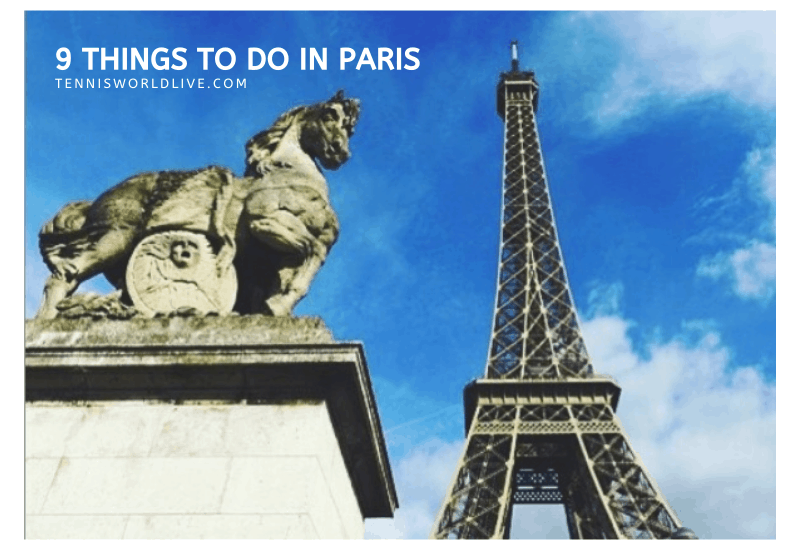
The next edition of the French Open will see some of the top tennis players in action and if you are a tourist or a sports fan who is looking to travel to Paris for the competition and if you already have a French Open ticket, you might be interested in what all you can do in Paris during the tournament. Here’s our exhaustive guide on the things to do in Paris during the French Open.
Spend an Evening at the Eiffel Tower
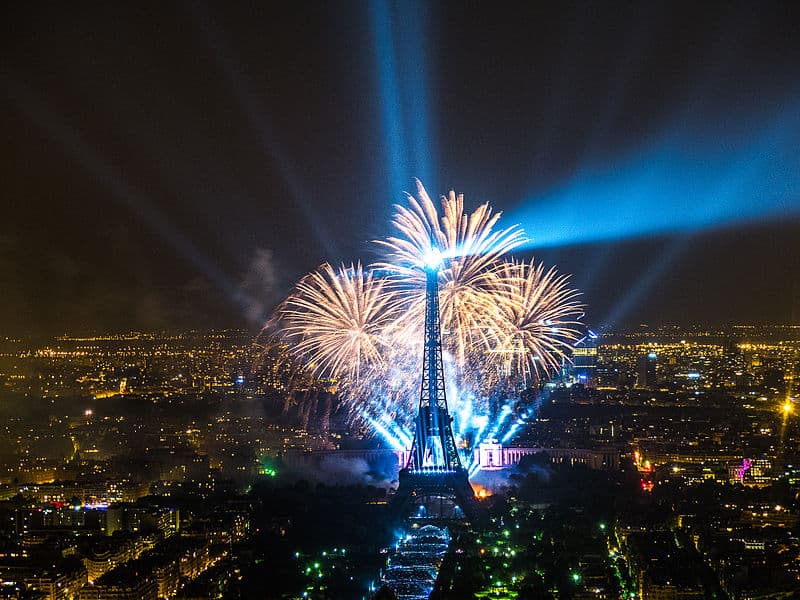
With more than seven million visitors a year, the Eiffel Tower is the world’s most visited paid monument. Created initially for the 1889 Exposition Universelle, and intended originally as a temporary structure, this wrought iron lattice tower has become one of the most recognisable structures in the world, and has become synonymous with Paris and France.
At 324 metres high, the Tower is the tallest structure in Paris, and can be seen from miles away. It has three levels for visitors – an upper platform with an observation deck, and two level levels, both of which offer restaurants and a range of gift shops. There are a number of public restrooms available as well.
The tower can either be ascended by lift or by taking the stairs, although access to the top floor is by elevator only. It is open 365 days a year from 9 am to 12.45 am during the summer, and 9.30 am to 11.45 pm during the rest of the year.
Whilst tickets can be bought online, they do require visitors to select a time for their visit. Turn up more than 30 minutes after your allotted time, and you run the risk of being denied entry.
Prices vary according to the age of the visitors, and whether they choose to take the stairs, or join the hordes crowding into the elevators.
Stair access: Prices start at €7 for the over 25s; 12 to 24-year-olds pay €5 and those between 3 and 11, pay €3.
Elevator access: Prices start at €11 for the over 25s; 12 to 24-year-olds pay €8.50 and those between 3 and 11, pay €4.
Observation platform: This must be purchased separately and can only be accessed by elevator. Prices start at €17 for the over 25s; 12 to 24 year olds pay €14.50 and those between 3 and 11 pay €8.
Children under three years old go free provided that they are accompanied by an adult, and there are discounts available for the disabled and their carers, and groups of more than 20 people.
Night time visitors can enjoy a 5 minute lightshow operated by 20,000 lightbulbs; these take place on the hour, starting at dusk.
Wait-times can be up to 2 hours during peak times during the summer. To avoid the crowds, it is best to arrive early in the day, and, if you are feeling fit enough, to climb the 704 steps to the second level. Try to avoid foggy days, as it will obscure the view from the top.
Those with smartphones can download an official Eiffel Tower app, which is available for Android and iOS devices at a cost of €2.99. The app offers an hour long audio tour of the Tower, describes its history, and the main points of view which can be seen from the top deck.
Visit The Louvre
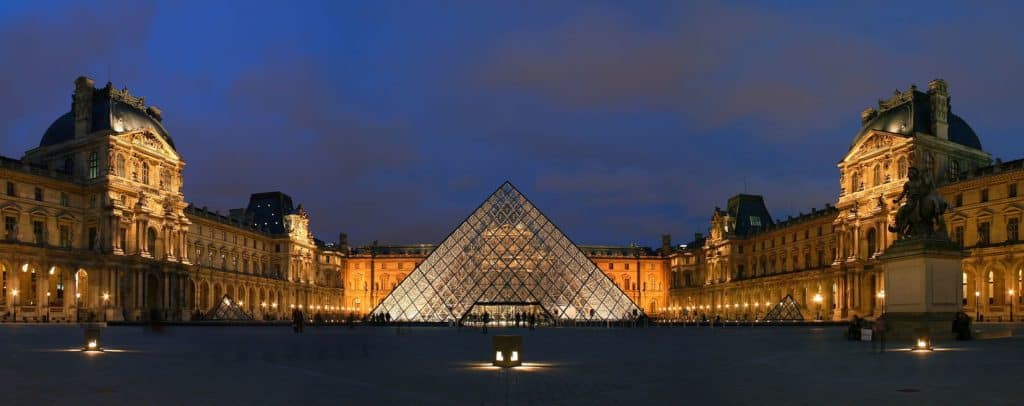
No visit to Paris is complete without a visit to the Louvre, which is probably one of the most famous museums in the world. Consisting of seven sub-galleries, which are distinctly defined by their content, these include the treasures of ancient Egypt, amazing artefacts from classical Greece and Rome, stunning sculptures, and an unparalled collection of Old Masters it is home to some of the most renowned works of art ever created. These include the Venus de Milo, Delacroix’s iconic Liberty Leading the People and the winged victory of Samothrace. And then, of course, there is Leonardo’s Mona Lia – probably the best-known picture ever painted.
But, not only is The Louvre the most famous museum in the world, it is also the most visited. Also, given that is half a mile long, and contains 35,000 permanent exhibits, it is impossible to see all the exhibits in one day, or even on several visits.
So don’t try. Instead decide before what you want to see, and carefully plan your visit so that you just stick to the exhibits you have chosen. Otherwise you will get too tired and it will spoil your enjoyment of the day. If there is something you miss this time, you can always come back. The Louvre has been open since 1793, and there are no plans for it to shut any time soon!
The Louvre is open every day from 9 am every day except Tuesdays and major public holidays. On Wednesdays and Fridays it is open to 9.45 pm; whereas it shuts at 6 pm on other days. Tickets can be bought at the door, but you may have to wait in a queue for an hour or more before you pass security. Alternatively, you can buy an e-ticket in advance for €17, which you can download on your smartphone, which gives you fast track access to the museum. You will be given a timeslot, so you must appear at the museum within 30 minutes of your designated slot.
Alternatively you could sign-up for one of the many “skip-the-line” guided tours which are advertised on-line. The prices of these vary between €35 and €60 per person.
Two final bits of advice. Get there early to avoid the worst of the crowds. And do wear comfortable shoes. However, well planned, a visit to the Louvre means a fair bit of time on your feet, so choosing the right footwear is important.
Visit the Notre Dame Cathedral
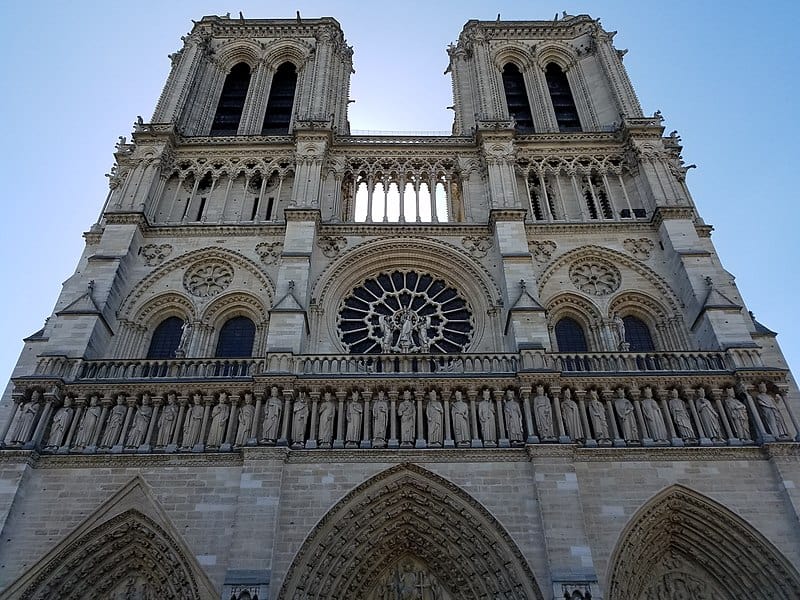
Notre Dame Cathedral, located in the heart of Paris in the Îde de la Cité, is the most visited monument in France, attracting even more visitors than the Eiffel Tower. Yes, that’s correct, the most-visited place in Paris isn’t the Eiffel Tower, but this very impressive monument that’s known for its French Gothic architecture, a style associated with the late medieval period. It is also the seat of the Archbishop of Paris.
It is also, of course, known as the home of the famous hunchback of Notre Dame. Sadly, those who will be hoping to see him during their visit will be disappointed as this mythical creature exists only in the imagination of Victor Hugo and Walt Disney!
Before even entering the Cathedral take time to admire the façade of the building and the two bell towers soaring into the Paris sky. Then take in the majesty of the carvings as you enter through one of the doors on the western side with allegories which, ranging from left to right, depict The Incarnation of the Blessed Virgin Mary, The Last Judgement, and The Death of Mary.
On entering the Cathedral itself, your attention will immediately be drawn to the three immense beautiful stained-glass Rose Windows which filter in the highlight, and are filled with scenes from the Bible. Particularly noteworthy is the one on the southern façade, which is nearly 13 meters wide, and which highlights the stunning architecture of the building with its soaring pillars and high vaulted ceilings.
In the sacristy, south of the choir, can be found the reliquary, which houses precious religious artefacts, including the highly revered Crown of Thorns, a part of the True Cross, and one of the Holy Nails from the crucifixion.
If you are feeling fit, then why not climb the 387 steps of the southern bell-tower and come face to face with Emmanuel, the largest bell in Paris, and the second largest bell in France? Cast in the 17th century, Emmanuel weighs over 13 tons, and is always the first bell to be run on special occasions and holidays.
The Cathedral is open for 8 am to 6.45 pm Monday to Fridays, and between 8 to 7.45 pm on weekends. It is free to enter, but if you want an audio guide, then you can buy a 35-minute guide at the entrance which gives you the background about the cathedral and its architecture.
In the summer months, free tours are offered on different days of the week in different languages such as English and Spanish, as well as French. Look online to see when the next available tour is scheduled.
When you have finished visiting the cathedral, try and find some time to explore the rest of the island. Situated on the original settlement of the City of Paris by ancient Celtic tribes, today it is home to a number of sights and monuments, including Sainte-Chapelle, one of the finest examples of high gothic architecture in Europe.
Then there is La Concergerie, where Marie Antoinette was held prior to her execution during the French Revolution and the Deportation Monument which commemorates the French victims of the Nazi Holocaust during World War 2. Finally, look out for the imposing Palais de Justice, the highest court in France.
Walk Down the Arc de Triomphe and Champs Ėlysées
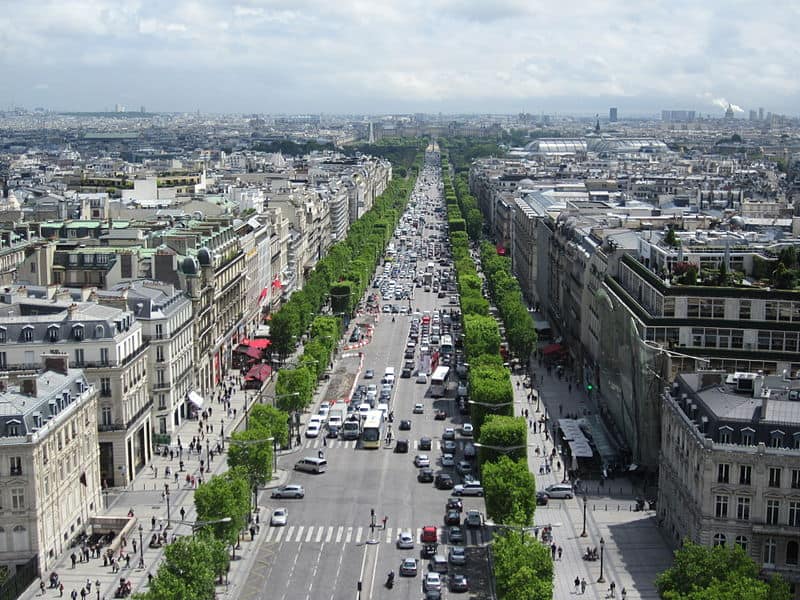
For any visitor to Paris the Arc de Triomphe and the Champs Ėlysées are must-see attractions.
The Arc de Triomphe is one of the most famous and recognised monuments in the world, instantly familiar to any visitors from a hundred films or picture postcards. Standing 50 meters high and 45 meters wider, the Arch, which was inaugurated in 1836, commemorates all those who fought for France in the French Revolution and Napoleonic Wars, and is also home to the tomb of the unknown soldier from the First World War.
Each of the Arc’s four pillars are sculpted with reliefs depicting scenes from the Revolution or Wars of Napoleon, whilst engravings record some of the famous French victories of the period, and the names of well-known military leaders of the time. There are also plaques commemorating some of the famous events which have occurred at the monument.
When you get to the Arc, take a lift to view a small museum depicting the history of the monument, or climb 46 extra steps to get to the time and enjoy panoramic view over the city.
A word of warning though.
The Arc is located in the Place Charles de Gaulle, which is essentially in the middle of a giant roundabout with 12 roads feeding into it. Do not attempt to cross the road unless you want the Arc de Triomphe to be the last place you ever visit on earth! Instead use one of the pedestrian underpasses located on either the Champs Ėlysées or the Avenue de la Grande Armée.
When you have finished the Arc, it is time to explore the Champs Ėlysées (literally Elysian Fields) itself, the most famous street in Paris. 1.9 kilometres long and 70 metres wide, it runs from the Arc de Triomphe at one end down to the Place de la Concorde at the other, the largest square in Paris and the location of many famous executions during Revolutionary times.
Today, the Champs Ėlysées is a tree-lined boulevard, home to many theatres, cafés, and high-end shops, and will be immediately recognisable to sports fans worldwide as it’s the last stop for the Tour de France cycle races every year.
Walk down the avenue, absorb the sights and sounds, and stop by in one of the bars or cafés for a relaxing drink. And, if you have the budget for it, you can also get your retail fix, although this is not the place to shop for the price conscious, as the stores and brands are aimed squarely at the luxury end of the market.
The Champs Ėlysées can easily be reached by metro, with stops at either end at Charles de Gaulle Ėtoile, and Concorde. There are also three stations with entrances on the boulevard itself – George V, Franklin D. Roosevelt, and Champs Ėlysées-Clemenceau.
Follow PSG play at the Parc des Princes in French Ligue 1 Football
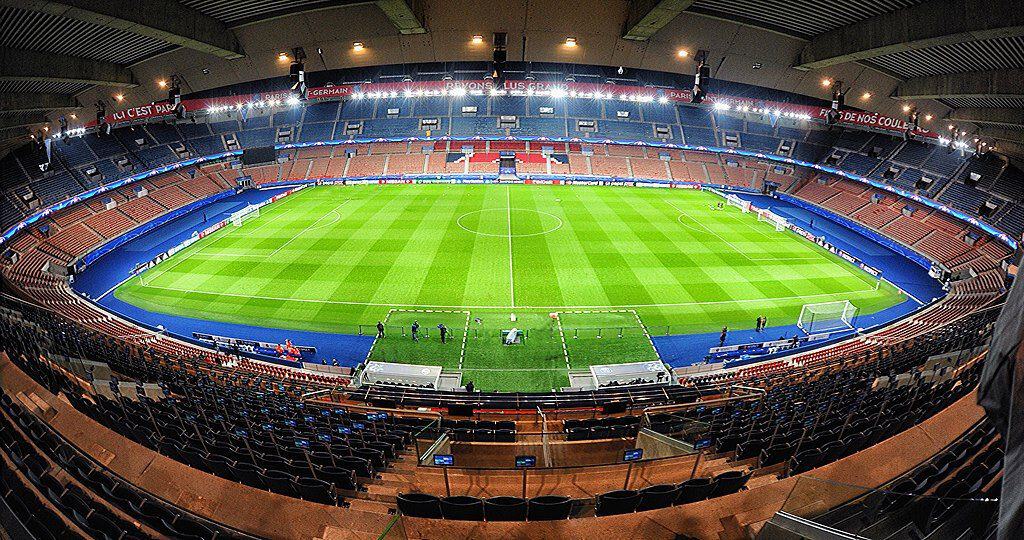
PSG or Paris Saint-Germain F.C. is a Paris-based football club that has been around for nearly five decades and has seven Ligue 1 titles – Ligue 1 is top football league in the country of France and PSG, in recent times, have been the best club side by some distance. So much so that as on December 2018, PSG has won the Ligue 1 titles on five of the previous six occasions.
The Ligue 1 competition begins in August every year and goes all the way up to the end of May, usually culminating into the season finale on the last Saturday of the month of May. With the French Open usually kick-starting a day or so after that, sports fans can treat themselves to a game of football – or soccer if you like in the USA – at the Parc des Princes in Paris where PSG are based.
Parc des Princes has a capacity of nearly 48k fans and has also played host to quite a few World Cup football matches apart from rugby World Cup games. To buy tickets to watch PSG play at this stadium, you can click here.
If you are unable to watch a game at the Parc des Princes, you could also look at the option to go on a guided tour of the stadium. The stadium is on top of Périphérique, a Parisian ring road and is less than four kilometres away from the Eiffel Tower, on its south-west direction. Incidentally, the Roland-Garros is a kilometre to its north.
Given the area that Parc des Princes is located in is a very dense Parisian one, there’s no shortage of bars and restaurants or as they call it, a ‘brasserie‘.
Browse through the Art at Musée D’Orsay

The Musée D’Orsay attracts more than three million visitors a year and no wonder, as it houses the most impressive collection of Impressionist art in the world.
Formerly housed in the Jeu de Palme, the collection was moved to its present location, which used to be a railway station and hotel, in 1986, and was expanded to accommodate many of the modern art works from the Louvre. Now it is devoted to art principally created in France between 1848 and 1914, including paintings, sculpture, photography, and the decorative arts.
The artists featured are a who’s who of the Impressionist and Post-Impressionist era, including Manet, Gaugain, Toulouse-Lautrec, and Seurat. There are no fewer than 86 paintings by Monet, as well as an extensive collection of Renoir’s work, and no less 24 works by Vincent van Gogh.
Monet’s Le Dejéuner sur L’Herbe (Luncheon on the Grass), Renoir’s Bal du Moulin de las Galette (Dance at le Moulin de la Galette), and van Gogh’s Le Chambre à Arles (bedroom at Arles) are just some of the iconic works contained in the museum that will be instantly familiar to everybody.
In addition to the permanent works of art, the Musée also hosts regular touring exhibitions, so check with their website here to check what is on during the time of your proposed visit.
The museum is open Tuesday to Sunday between 9.30 am and 6 pm except Thursdays when it stays open until 9.45 pm in the evening. It is closed on Sundays, and on all major public holidays.
Ticket prices start at €14 for adults; there are concessions available accompanied children, and those between 18 to 25. Those who arrive after 4.30 pm on a normal day or 6 pm on a Thursday will be charged a reduced fee of €11.
Like many attractions in Paris the museum gets very busy in peak periods and you can expect to stand up to half an hour in the queue to get in. Try and get there early, or take advantage of the late opening hours on Thursday. Alternatively, you can take advantage of one of the many tours that offer a skip the line option –these starts from €16.
The museum is located on the left bank of the Seine opposite the Tuileries Gardens, and just across the river from the Louvre. The easiest way to get there is by Metro – either choose to alight at the station Musée d’Orsay on the RER C, or station Solferino on Line 12.
Visit The Palace of Versailles
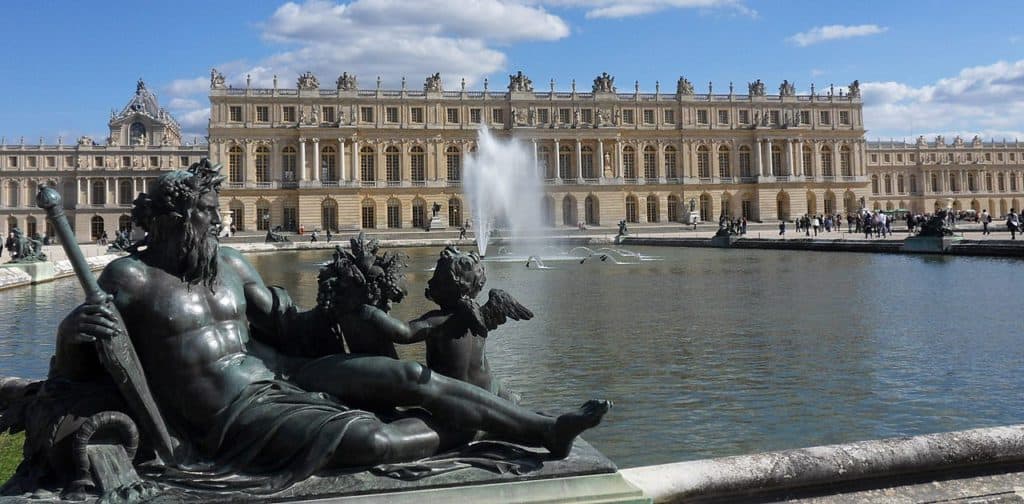
One of France’s biggest attractions is the Palace of Versailles, located some 20 kilometres to the south-west of Paris. Now a UNESCO World Heritage site, it was the royal residence of the Kings of France from 1682 until the French revolution and is particularly associated with the reign of Louis XIV, the Sun King. More recently, it was where the Treaty of Versailles that formally ended the First World War was signed in 1919.
The Palace complex contains over 2,000 rooms, although only of the grand apartments and galleries are open to the public. However, there is more than enough to occupy a visitor, especially when the sumptuous gardens and surroundings are taken into account.
The first glimpse of the Palace will stop you in its tracks with its enormous brick-built façade complete with columns and multiple embellishments in a U-shaped layout around a marble paved courtyard with secondary wings extending on either side.
On entering the palace itself look out for the King’s States Apartments, consisting of seven salons each named after a Roman deity and each with their own theme – Hercules, Venus, Abundance, Mars, Apollo, Diana and Mercury. Then visit the Hall Of Mirrors, perhaps the most famous room in the building. More than 70 meters long it is so-named because of the 17 mirrors which reflect back the windows facing the gardens on the opposite wall. It was here that the Treaty of Versailles was signed.
Next look out for the Queens’ Apartments, which were maintained as separate rooms for the consorts of the Kings of France, including the ill-fated Marie-Antoinette.
Finally, visit the Royal Chapel, the tallest building in the complex, which hosted daily services, royal weddings and baptisms and is splendidly decorated, evoking the majesty of a by-gone era.
However, your visit is by no means over, as you should spend time exploring the gardens which are every bit as splendid as the Palace itself, including the Orangery and the fountains. And then, just a short walk away is the estate of Trianon, a mini-refuge that Marie-Antoinette created for herself and her children, before their world was rudely shattered by the events that led to the French Revolution and the guillotine for her and her husband Louis XVI.
The easiest way to get to Paris is by train, taking the RER Line C, from the Pont de l’Alma stop. The cost of the trip is €7 for a return journey. The train journey will take about 30 minutes, and then, when you alight at the terminus, the Palace itself is just 5 minutes’ walk away. It is very well signposted, and, if you follow the crowds, you can be sure not to miss it!
Versailles is a very popular attraction and it can take an hour or more to get in if you choose to buy your tickets on the day. The best option is to pre-book your tickets through the official website in advance or opt for one of the “skip-the-line” tours that are offered. Basic entry costs start from €18, with an audio guide included.
Interested in the Disneyland, Paris?

For those who are tired of visiting all the historic attractions that Paris has to offer, or who are looking for enjoyment of a different kind, then a trip to Disneyland Paris might be in order. Based on the original Disneylands in California and Florida, it is the most visited theme park in Europe, with many of the same attractions and rides as its transatlantic “cousins”.
Formerly known as Euro Disney, the Park is home to 49 attractions spread across 5 themed “lands”, with a wheel-shaped on Central Plaza in front of le Château se la Belle au Bois Dormant (Sleeping Beauty’s Castle).
The five lands are: Main Street USA which serves as the main entrance into the park, and is themed around an early 20th century small American town: Adventureland which is covered in jungle to suggest exotic locations like India, Africa and the Caribbean; Discoveryland which reflects the ideas and concepts of some of Europe’s great thinkers, including France’s own Jules Verne; Fantasyland which includes many of the rides for younger children; and Frontierland which is themed around a 19th century mining town in the American Old West.
Amongst the best known rides are Pirates of the Caribbean, Indiana Jones and the Temple of Peril, Big Thunder Mountain, and the Thunder Mesa Riverboat Landing. Visitors can choose to walk through the park or take the narrow gauge Disneyland Railroad which snakes its way around the perimeter of the park, with stops in Mainland USA, Discoveryland, Fantasyland, and Frontierland.
When you have finished in the main Park, then move next door to the Walt Disney Studios Park which takes you behind the scenes as you explore the magic that helps produce many of their television programmes and film productions, with themed rides based on popular Disney shows like Cars, the Little Mermaid and 101 Dalmatians.
Apart from the standing attractions, the main Park has a range of daytime and night-time entertainments, including shows and parades, throughout the year, including the Jedi Training Academy, and Disney Stars on Parade. Check online before your visit to see what is on, and at what time.
There are also numerous themed restaurants and cafés throughout the complex, offering everything from quick snacks to full-course meals.
To get to Disneyland Paris take an over ground (RER) train from the centre of Paris, from either Châteleh les Halles, Gare de Lyon or Nation to the station Marne-la-Vallée – Chessy.
For those who pre-book, the daily cost for entrance to the park for those aged 12 years and over is between €36 and €57, depending on which day of the week you want to visit; for children (under 12 years of age), the cost varies between €30 and €51.
Gates open at 9.30 am and close at 11 pm in the summer, although the Walt Disney Studios Park closes earlier.
Visit the Montmartre and Sacré-Coeur
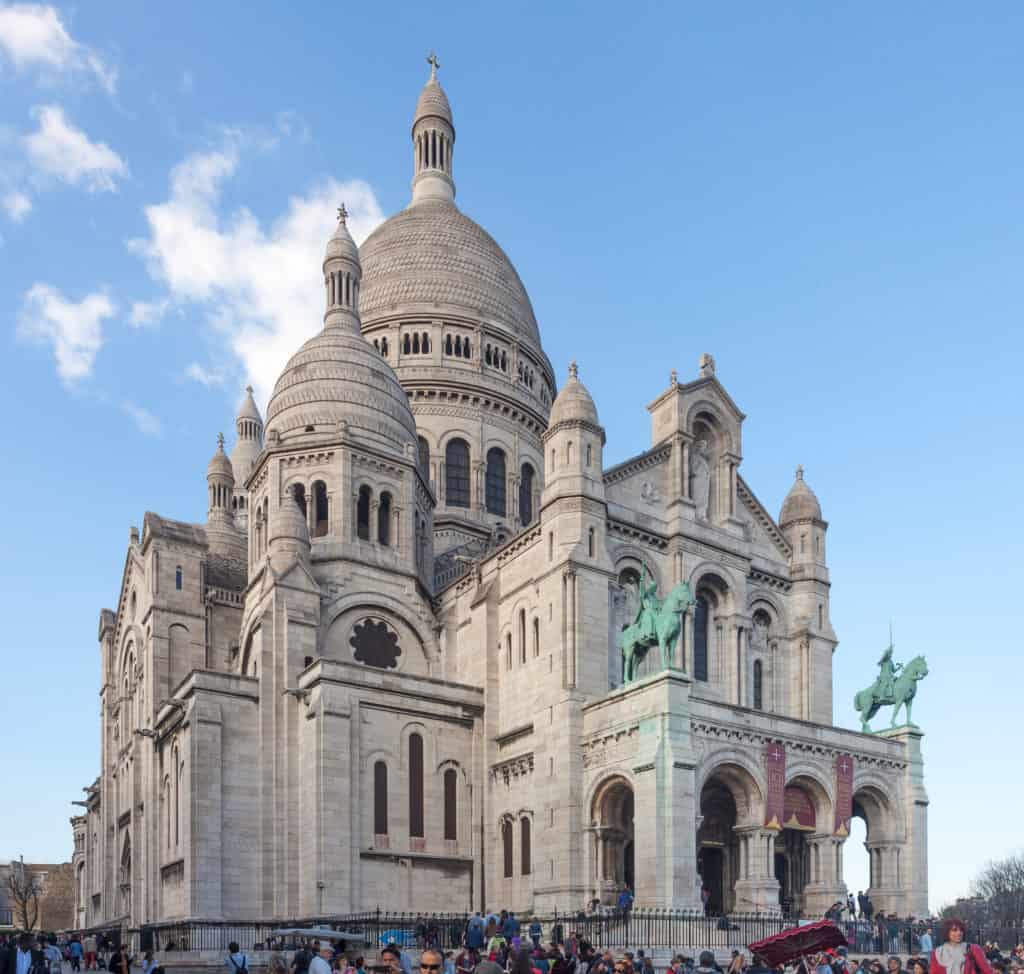
One of the most popular area to visit in Paris is Montmartre in the north of the city, renowned for its artistic heritage, the Basilica of Sacré-Coeur (Sacred Heart), and for those who are night-owls, as a nightclub district (the world famous Moulin Rouge is located in neighbouring Pigalle).
Designated by the French government as a historic district in order to preserve its unique character, the area is best-known for its association with the Impressionist and Post-Impressionist artist movements of the late 19th and early 20th centuries, where many famous artists – Renoir, Dégas, Van Gogh, Modigliani and a host of others – lived and worked.
To commemorate this time, visit the Musée de Montmartre which contains paintings by Henri Toulouse-Lautrec, Maurice Utrillo and Suzanne Valadon, as well as a collection of photography, manuscripts and posters that depict the rich history of the district.
Then climb the steps to visit the Basilica of Sacré-Coeur, whose white dome is one of the best-known symbols of the city. Built to commemorate the suffering of the city of Paris during the Franco-Prussian War and the 1871 Commune, Sacré-Coeur, is built on the summit of the butte de Montmartre, and is the highest point in the city.
Take the stairs to the top of the dome and enjoy panoramic views over the entire city, especially on a clear day. Visitors may also enjoy a visit to the Basilica’s garden and its fountain, an oasis of peace in the bustling city.
Just a stone’s throw away from Sacré-Coeur is the Place du Tertre, a square where the modern-day descendants of the impressionists set-up their easels every day, as the tourists mill around them. Formerly home to the likes of Pablo Picasso and Salvador Dali, today it is full of bars and cafés, and a beguiling spot to spend an hour or two as you enjoy the lingering memories of The Belle Époque.
The visitor to the area may want to ride the funicular railway, the Funiculaire de Montmartre which they can take up the hill from the south, or ride the Montmartre bus which climbs the hill. Those with smaller children may also want to consider “le petit train” which winds its way slowly around the main streets of the area.
To get to Montmartre, take the Metro: either Line 2, alighting at Pigalle, Anvers, or Blanche; or Line 12, with a choice of either Pigalle, Jules Joffrin, or Lamarck-Caulaincourt stations.